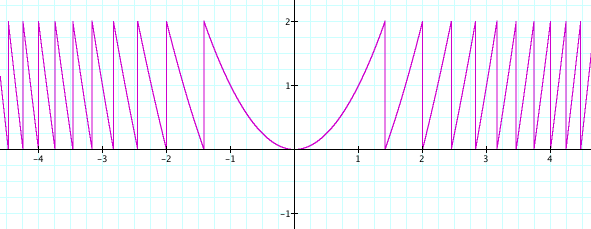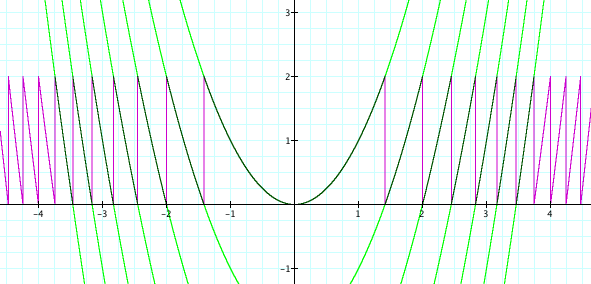During class we went through several activities, including this one, where you had to first build an action conception of a formula, then we built a process conception of the same formula by employing "variables vary, go slow!" As a reminder, here is the activity we did.
We normally think that b and a in "a mod b" stand for whole numbers. 27 mod 3 is 0, because 27 ÷ 3 has remainder 0. 27 mod 5 is 2, because 27 ÷ 5 has remainder 2. But we can think generalize this idea to fractions and irrational numbers, too. The definition of "b mod a" that does this is:
(a mod b) is the remainder obtained when subtracting mb from a, where m is the largest integer less than or equal to
![]() .
.
By this definition, (6.5 mod 2.1) = 0.2, since 3 is the greatest integer less than or equal to
![]() , and 6.5 - (3)(2.1) = 0.2. Similarly, (6.5 mod -2.1) = -1.9 because –4 is the largest integer less than or equal to
, and 6.5 - (3)(2.1) = 0.2. Similarly, (6.5 mod -2.1) = -1.9 because –4 is the largest integer less than or equal to
![]() and 6.5 – (-4)(-2.1) = -1.9 (you should determine this for yourself).
and 6.5 – (-4)(-2.1) = -1.9 (you should determine this for yourself).
In class, we spent a considerable amount of time wherein you practiced how to calculate (a mod b) for various values of a and b. After calculating many values, you came to the realization that the result would always be positive when the b (the modulus) is positive, and that the result will always be negative when the modulus is negative. We then went through the example of "what will the graph of y = mod(x2,2) look like?" Again, we employed the mantra "variables vary, go slow!" to figure out that the graph will look like this:

We also reasoned that the graph's overall behavior is like y=x2 for x being between 0 and square √2, like y=x2-2 for x between √2 and 2, like y=x2-4 for x between 2 and √6, etc. We checked this by graphing each of these functions on top of the graph of y = mod(x2,2), getting this:

At each stage, we explained why the graphs behave as they do, and our explanations were rooted in the definition of mod(a,b) in conjunction with the idea that as x varies the value of mod(x2,2) varies.
Extension
Given that a mod b is defined as above, do this for the first four functions in the following list: (a) predict its behavior, giving your reasoning behind your prediction; (b) explain its actual behavior. (We did f1 in class. You can repeat it for practice if you wish, but it is not mandatory.) Please consider the last one as a challenge question.
-
f1(x) = mod(x2,2)
- f2(x) = x + mod(x2,2)
-
f3(x) = mod(x3,2)
- f4(x) = mod(x2,x)
-
f5(x) = mod(x2,cos(x))
Pedagogy
What lessons have you learned from this assignment with regard to how you might help students develop process conceptions of function definitions and covariational understandings of functions?